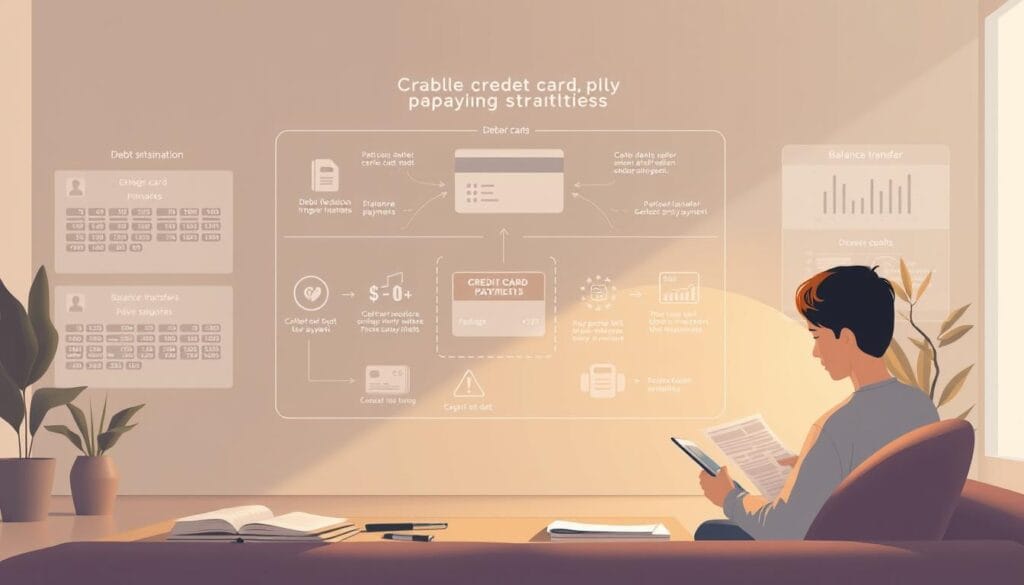Over 40% of Americans aged 65-74 now carry credit card balances – a 52% surge since 1989. Households in this group owe a median $2,850, while those over 75 face $2,700 in card debt, according to Federal Reserve data. For retirees living on fixed incomes, these balances often become financial quicksand.
Soaring costs for essentials like housing and healthcare force many older adults to rely on plastic for basics. But paying just the required monthly amount creates a dangerous cycle. Most of each payment goes toward interest rather than reducing the principal, meaning a $3,000 balance could take 15+ years to clear.
Retirees face unique hurdles: Limited income streams and fewer options to earn extra money make escaping debt especially tough. With inflation stretching budgets thinner, understanding how interest compounds becomes critical for protecting hard-earned savings.
Key Takeaways
- Credit card debt among seniors has nearly doubled since 1989
- Minimum payments primarily cover interest, not principal balances
- $3,000 debt could take decades to pay off at minimum rates
- Fixed incomes limit options for increasing repayment amounts
- Inflation pressures make debt management strategies essential
Understanding Debt Challenges for Seniors

Fixed incomes and rising costs are pushing a growing number of retirees into relying on plastic for everyday needs. Social Security checks and pension payments rarely keep pace with inflation, creating a dangerous mismatch between earnings and bills.
When Income Stops Growing
Most retirement funds grow at 1-3% annually, while essential costs like prescription drugs and housing surge by 6-8%. This gap forces difficult choices:
| Income Sources | Monthly Expenses | % of Budget |
|---|---|---|
| Social Security | Healthcare | 42% |
| Pensions | Utilities | 23% |
| Savings | Groceries | 19% |
Essential Spending Becomes Debt Fuel
Jessica Johnston from the National Council on Aging explains:
“When Medicare doesn’t cover dental work or home repairs, credit cards become emergency tools. Each charge adds to a balance that could take years to clear at today’s rates.”
Many retirees use cards for basics like insulin co-pays or furnace repairs. Unlike younger borrowers, they can’t maximize Social Security benefits through delayed claims once debts mount.
This financial strain often remains hidden. Only 1 in 4 seniors discuss money worries with family, according to AARP research. The silence compounds the problem.
The Impact of Minimum Payments on Interest and Debt Growth

Nearly 1 in 3 cardholders nationwide stick to baseline repayments, a strategy that costs retirees $7,200+ in extra interest per $5,000 balance. Credit card companies typically calculate required amounts as 2% of the total owed plus fees – a formula favoring endless interest accumulation.
How Minimum Payments Can Lead to Accumulated Interest
Consider a $5,000 balance with 19% APR:
- Minimum payment: $100 (2% + $25 fee)
- Interest charges: $79/month initially
- Principal reduction: Just $21/month
At this rate, clearing the debt takes 27 years – longer than most retirement planning horizons. Daily compounding worsens the math: a $300 medication purchase could add $0.16 in interest every single day.
“Minimum amounts act like financial quicksand – the harder you struggle, the deeper you sink,” explains financial educator Martin Lewis.
Many retirees face negative amortization when unexpected expenses force new charges. A $200 car repair paid via credit while making minimums might actually increase the total owed after interest calculations.
| Payment Strategy | Payoff Time | Total Interest |
|---|---|---|
| Minimum ($100) | 27 years | $7,240 |
| $150 Monthly | 4 years | $1,880 |
| $250 Monthly | 2 years | $620 |
Those struggling with high rates should explore alternative financing options to break the cycle. Even $50 extra monthly cuts repayment timelines by 60% – a crucial adjustment for fixed-income households.
Effective Strategies to Manage Credit Card Debt

Breaking free from mounting balances requires a clear roadmap. Two proven approaches – the snowball and avalanche methods – offer structured paths to financial freedom.
Utilizing the Snowball and Avalanche Methods
The snowball method creates momentum by eliminating small balances first. Here’s how it works:
- Pay minimum amounts on all credit cards
- Apply extra money to the smallest balance
- Roll payments to next target after each payoff
Financial coach Diane Saunders notes:
“Clients using snowball repay 23% faster – quick wins boost confidence to tackle larger debts.”
The avalanche method prioritizes math over motivation:
| Method | Focus | Savings Potential |
|---|---|---|
| Snowball | Small balances | Faster emotional wins |
| Avalanche | Highest interest rate | 20-30% less paid overall |
Budgeting Techniques and Expense Monitoring
Track spending with low-tech solutions that work:
- Envelope system for cash expenses
- Notebook tracking of daily purchases
- Weekly review of bank statements
Identify hidden drains like unused subscriptions or duplicate services. Seasonal utility costs and medical copays should have dedicated budget lines. Debt calculators help visualize how extra payments accelerate progress.
Balance financial discipline with quality-of-life spending. Allocate 5-10% of income for social activities while directing surplus funds to debt reduction. Regular check-ins prevent old habits from creeping back.
avoid minimum payments reasons seniors
Modern credit systems often exploit financial habits through carefully designed repayment structures. What appears as manageable monthly amounts frequently becomes a decades-long burden for older adults. With the Federal Reserve’s rate hikes pushing average APRs above 20%, balances grow faster than many fixed-income households can manage.
Understanding the Traps of Low Payment Options
Creditors calculate required amounts to maximize interest earnings. A typical $200 payment on a $8,000 balance might only reduce principal by $38 initially. At this rate, clearing the debt could take until age 95 for a 70-year-old.
Financial analyst Theresa Rodriguez explains:
“These plans create psychological safety nets. Retirees think ‘I can handle $200 monthly’ without realizing they’re committing to 25 years of payments.”
Three critical factors worsen the cycle:
- Compounding daily interest on new charges
- Automatic credit limit increases tempting further spending
- Fees that kick in during financial emergencies
Many discover their balances increase despite consistent payments after unexpected medical bills or home repairs. This “debt treadmill” effect leaves 68% of retirees over 75 still carrying card balances according to recent Pew Research.
Those needing immediate relief should explore safer borrowing options while restructuring existing obligations. Even $75 extra monthly can slash repayment timelines from decades to years, preserving retirement savings.
Utilizing Credit Counseling and Debt Management Options
Certified credit counselors help older adults reduce credit card interest rates by 50% on average through structured repayment plans. Nonprofit agencies provide tailored strategies to break debt cycles faster than minimum payments allow. Credit counseling services analyze income, expenses, and balances to create realistic solutions.
Benefits of Professional Guidance and Negotiation
Debt management plans (DMPs) consolidate multiple payments into one monthly amount. Counselors negotiate with credit card companies to:
- Lower interest rates to 8-12% (vs. 20%+ standard)
- Waive late fees and over-limit charges
- Freeze new charges on accounts
Financial advisor Mark Thompson notes:
“A $10,000 balance paid through DMPs clears in 4 years versus 22 years with minimum payments. That’s $9,200 saved in interest.”
Reputable agencies like those accredited by the National Foundation for Credit Counseling charge startup fees under $50. They provide:
| Service | Benefit |
|---|---|
| Budget coaching | Aligns spending with fixed incomes |
| Creditor communication | Stops collection calls |
| Progress reports | Tracks debt reduction milestones |
Combining DMPs with credit score improvement tools creates lasting financial health. Counselors help rebuild credit while managing existing obligations.
Innovative Financial Tools and Free Resources for Seniors
Retirees now have unprecedented access to digital tools and support programs designed to simplify money management. These resources help tackle credit card debt while preserving limited incomes.
Exploring Online Budgeting Tools and Boot Camps
The Consumer Financial Protection Bureau offers a free Get a Handle on Debt boot camp. This program teaches practical skills like negotiating with credit card companies and creating repayment plans. Users learn to:
- Track expenses using mobile apps
- Prioritize high-interest debt
- Build emergency savings buffers
Interactive courses break complex topics into 10-minute daily lessons. Many retirees report saving $200+ monthly after completing the training.
Government and Nonprofit Assistance Programs
NCOA’s BenefitsCheckUp connects older adults with 2,500+ assistance programs. Users often qualify for:
- Medicare prescription cost reductions
- Utility bill payment plans
- Free legal debt management services
Creditors frequently offer hardship options like reduced interest rates when contacted directly. For urgent needs, installment loans provide structured repayment plans without revolving balances.
Combining these tools with consistent budgeting helps retirees regain control. Regular check-ins with nonprofit advisors ensure strategies stay aligned with changing financial needs.

